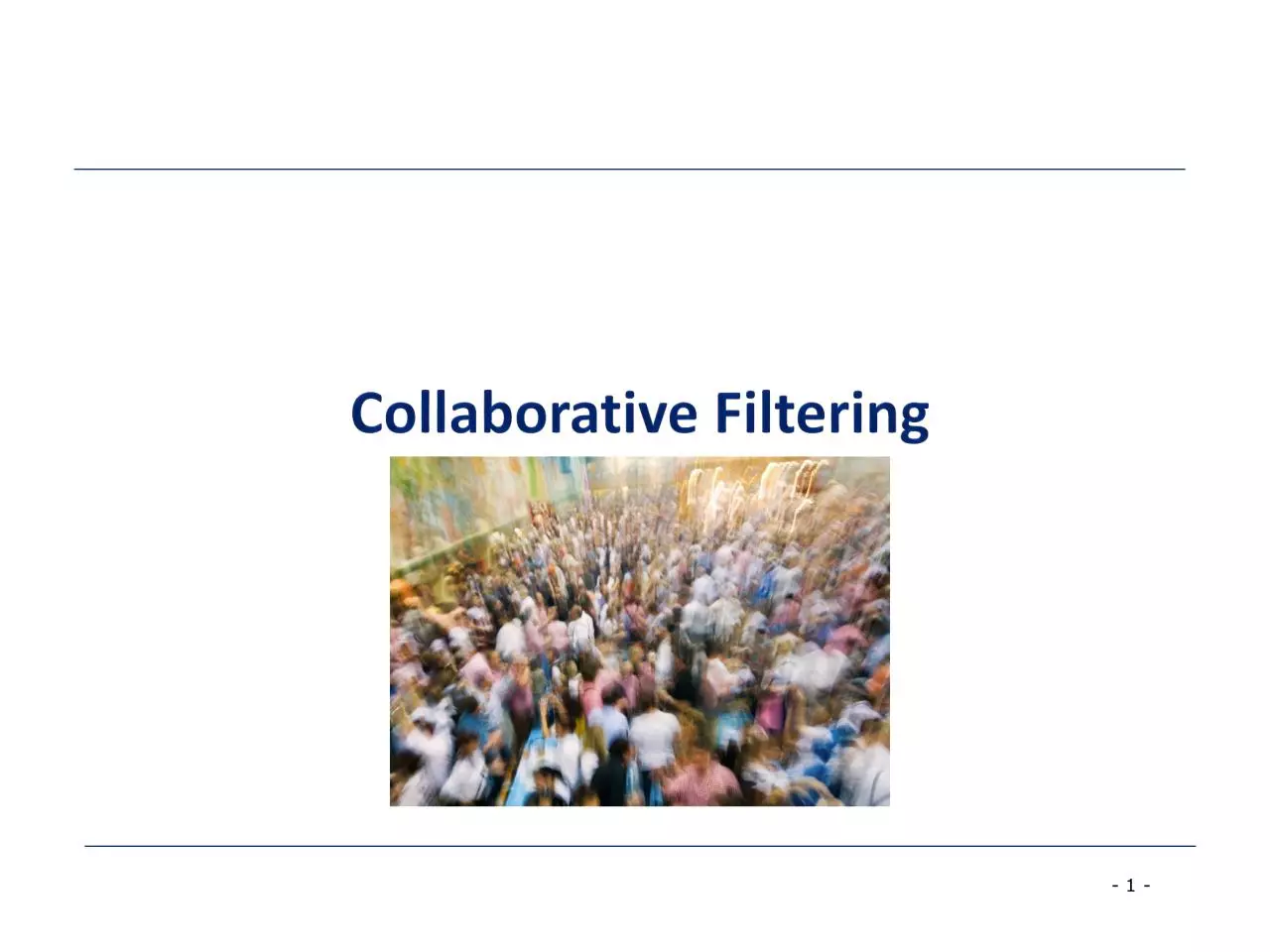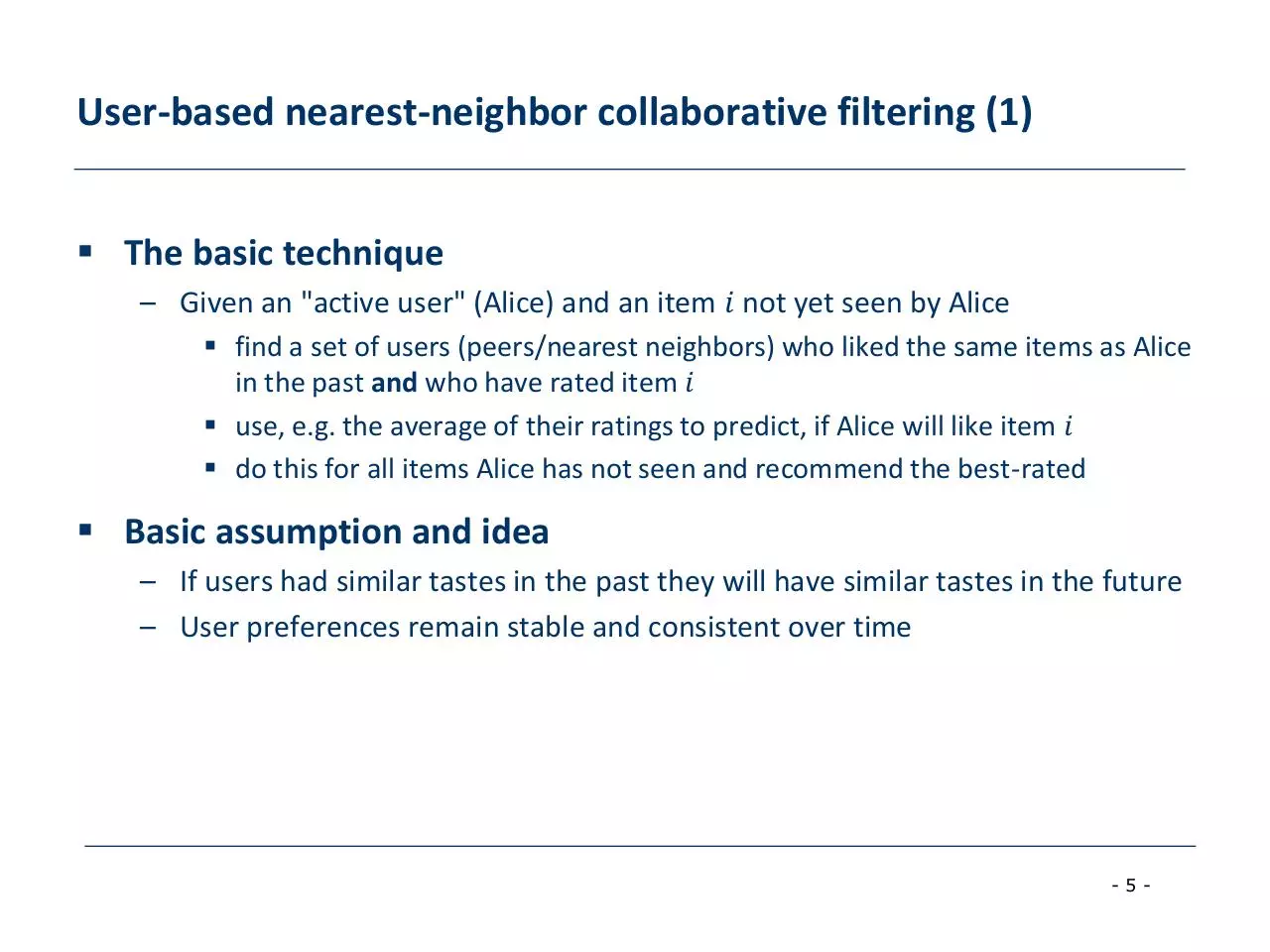Collaborative recommendation (PDF)
File information
Title: Recommender Systems
Author: markus
This PDF 1.5 document has been generated by Microsoft® PowerPoint® 2013, and has been sent on pdf-archive.com on 05/11/2015 at 23:21, from IP address 41.176.x.x.
The current document download page has been viewed 634 times.
File size: 1.3 MB (46 pages).
Privacy: public file





File preview
-1-
Agenda
Collaborative Filtering (CF)
–
–
–
–
–
–
–
–
–
–
–
Pure CF approaches
User-based nearest-neighbor
The Pearson Correlation similarity measure
Memory-based and model-based approaches
Item-based nearest-neighbor
The cosine similarity measure
Data sparsity problems
Recent methods (SVD, Association Rule Mining, Slope One, RF-Rec, …)
The Google News personalization engine
Discussion and summary
Literature
-2-
Collaborative Filtering (CF)
The most prominent approach to generate recommendations
– used by large, commercial e-commerce sites
– well-understood, various algorithms and variations exist
– applicable in many domains (book, movies, DVDs, ..)
Approach
– use the "wisdom of the crowd" to recommend items
Basic assumption and idea
– Users give ratings to catalog items (implicitly or explicitly)
– Customers who had similar tastes in the past, will have similar tastes in the
future
-3-
Pure CF Approaches
Input
– Only a matrix of given user–item ratings
Output types
– A (numerical) prediction indicating to what degree the current user will like or
dislike a certain item
– A top-N list of recommended items
-4-
User-based nearest-neighbor collaborative filtering (1)
The basic technique
– Given an "active user" (Alice) and an item 𝑖 not yet seen by Alice
find a set of users (peers/nearest neighbors) who liked the same items as Alice
in the past and who have rated item 𝑖
use, e.g. the average of their ratings to predict, if Alice will like item 𝑖
do this for all items Alice has not seen and recommend the best-rated
Basic assumption and idea
– If users had similar tastes in the past they will have similar tastes in the future
– User preferences remain stable and consistent over time
-5-
User-based nearest-neighbor collaborative filtering (2)
Example
– A database of ratings of the current user, Alice, and some other users is given:
Item1
Item2
Item3
Item4
Item5
Alice
5
3
4
4
?
User1
3
1
2
3
3
User2
4
3
4
3
5
User3
3
3
1
5
4
User4
1
5
5
2
1
– Determine whether Alice will like or dislike Item5, which Alice has not yet
rated or seen
-6-
User-based nearest-neighbor collaborative filtering (3)
Some first questions
– How do we measure similarity?
– How many neighbors should we consider?
– How do we generate a prediction from the neighbors' ratings?
Item1
Item2
Item3
Item4
Item5
Alice
5
3
4
4
?
User1
3
1
2
3
3
User2
4
3
4
3
5
User3
3
3
1
5
4
User4
1
5
5
2
1
-7-
Measuring user similarity (1)
A popular similarity measure in user-based CF: Pearson correlation
𝑎, 𝑏 : users
𝑟𝑎,𝑝 : rating of user 𝑎 for item 𝑝
𝑃
: set of items, rated both by 𝑎 and 𝑏
– Possible similarity values between −1 and 1
𝒑 ∈𝑷(𝒓𝒂,𝒑
𝒔𝒊𝒎 𝒂, 𝒃 =
𝒑 ∈𝑷
− 𝒓𝒂 )(𝒓𝒃,𝒑 − 𝒓𝒃 )
𝒓𝒂,𝒑 − 𝒓𝒂
𝟐
𝒑 ∈𝑷
𝒓𝒃,𝒑 − 𝒓𝒃
𝟐
-8-
Measuring user similarity (2)
A popular similarity measure in user-based CF: Pearson correlation
𝑎, 𝑏 : users
𝑟𝑎,𝑝 : rating of user 𝑎 for item 𝑝
𝑃
: set of items, rated both by 𝑎 and 𝑏
– Possible similarity values between −1 and 1
Item1
Item2
Item3
Item4
Item5
Alice
5
3
4
4
?
User1
3
1
2
3
3
sim = 0,85
User2
4
3
4
3
5
sim = 0,00
User3
3
3
1
5
4
sim = 0,70
User4
1
5
5
2
1
sim = -0,79
-9-
Download Collaborative recommendation
Collaborative_recommendation.pdf (PDF, 1.3 MB)
Download PDF
Share this file on social networks
Link to this page
Permanent link
Use the permanent link to the download page to share your document on Facebook, Twitter, LinkedIn, or directly with a contact by e-Mail, Messenger, Whatsapp, Line..
Short link
Use the short link to share your document on Twitter or by text message (SMS)
HTML Code
Copy the following HTML code to share your document on a Website or Blog
QR Code to this page

This file has been shared publicly by a user of PDF Archive.
Document ID: 0000313014.